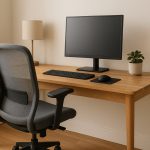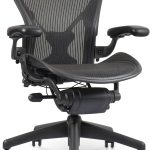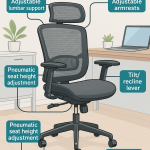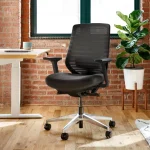If you’ve finally upgraded to one of the top ergonomic office chairs for back pain, congratulations! But here’s the surprising truth: just having a great chair isn’t enough. Many people still end up uncomfortable, stiff, or even in pain—simply because they’re not using their chair the right way.
Ready to sit smarter and get the most relief every day? Let’s uncover the five most common mistakes and how to avoid them.

1. Ignoring the Lumbar Support Adjustment
Many ergonomic office chairs come with built-in or adjustable lumbar support—but lots of users never touch the settings! The lumbar pad should fit snug in the curve of your lower back, not too high or too low. If your lumbar support is off, you might still slouch, which defeats the whole purpose.
Quick Fix:
Take a minute to slide, rotate, or pump up the lumbar section so it follows your spine’s natural S-shape.
Tip: If you’re not sure it’s positioned right, place your hand at your lower back while sitting—you should feel gentle support, not pressure or a gap.
The correct lumbar support position aligns with the lower back’s inward curve, providing gentle contact that maintains posture and reduces spinal stress.
For premium performance, read our Aeron review here.
2. Setting Seat Height Incorrectly
Having your feet dangle or knees jammed up against the edge of your seat? That’s a big no-no for comfort and circulation. Your ergonomic chair’s seat height needs to allow your feet to rest flat, with your knees about level with your hips.
How to Fix It:
Lower or raise the chair until you’re sitting comfortably—soles flat, with a bit of space between the back of your knees and the seat edge. A footrest can help shorter users.
Real Example:
When one of our readers switched from a fixed-height dining chair to an adjustable ergonomic model, she immediately noticed her lower-leg swelling disappeared within days. Correct seat height alone can improve blood flow and prevent numbness.
3. Ignoring Armrest Adjustments
Armrests are not just decoration! They’re designed to reduce tension in your shoulders and neck. Skip the adjustment, and you’ll likely shrug your shoulders or hunch forward—classic moves for causing pain.
Quick Tip:
Adjust your armrests so your arms rest lightly, elbows at a 90-degree angle, and shoulders relaxed. Your forearms should parallel the desk, letting your wrists stay straight.
Many experts suggest checking this alignment weekly since cushions compress and posture habits drift over time.
4. Not Taking Breaks (Even with a Great Chair!)
Think your ergonomic office chair is a ticket to all-day sitting? Think again. Even the best chair can’t replace the need for regular movement. Skipping breaks leads to stiffness, poor circulation, and, yes, more back pain.
See our detailed recommendations on ergonomic chairs for back pain relief.
Smart Solution:
Set a timer to stand, stretch, or walk for a minute every 30–60 minutes. Try the 20-8-2 rule endorsed by ergonomists:
- 20 minutes sitting,
- 8 minutes standing,
- 2 minutes moving or stretching.
This simple rhythm promotes energy, posture recovery, and spinal hydration throughout the day.
5. Forgetting About Desk Height and Position
Sometimes, the chair is set up perfectly—but your desk is too high, too low, or doesn’t give you space to tuck in. Poor desk alignment can force you into harmful postures, no matter how “ergonomic” your office chair is.
How to Check:
- Sit naturally in your chair and pull close to your desk.
- Your elbows should rest comfortably at keyboard height (around 90°).
- The top third of your screen should be at eye level.
- Keep frequently used items (mouse, notebook, coffee mug) within arm’s reach to reduce twisting.
Checklist: Perfect Desk-Chair Alignment
- Elbows at 90° and close to the body
- Feet flat or on a footrest
- Monitor about arm’s length away
- Screen top slightly below eye level
- Lumbar curve supported, not forced
Bonus Mistake #6: Using the Wrong Chair for Your Body Type
Not all ergonomic chairs fit everyone. Seat depth, width, and backrest curvature vary widely.
If you’re tall, a short seat pan can cut circulation behind your knees; if you’re petite, an oversized backrest may push your shoulders forward. Always check the manufacturer’s recommended height range or try before buying.
Pro Tip: Adjustable seat depth (usually 1.5–2 inches of travel) lets you fine-tune comfort for your height. Chairs like the Steelcase Leap or SIHOO M18 excel at this.
7. Bonus Mistake #7: Forgetting to Re-Evaluate Your Setup Over Time
Ergonomics isn’t “set it and forget it.”
Over months of use, chair cushions compress, your posture changes, and desk layouts shift. Revisit your setup every few weeks.
Ask yourself:
- Do I still feel lumbar contact?
- Are my shoulders relaxed?
- Do I need to adjust monitor or desk height?
Making micro-adjustments keeps your body aligned and your investment worthwhile.
🧠 FAQs
You should feel even weight on both hips, no numbness in your legs, and gentle lumbar support along your lower back curve.
At least once a month—or anytime you notice new stiffness or after moving your desk setup.
Seat depth. A seat that’s too long pushes you forward and reduces lumbar contact. Aim for 2–3 fingers of space behind your knees.
Final Thought: Comfort Is in the Details
Getting the full benefits of ergonomic office chairs for back pain is about more than picking a top-rated model—it’s about dialing in the details for your body and your workspace. Take 10 minutes to check your setup, adjust your chair, and move regularly. It’s a small routine that pays off with big comfort.
Explore our ergonomic chair roundup for more models and comparisons.






